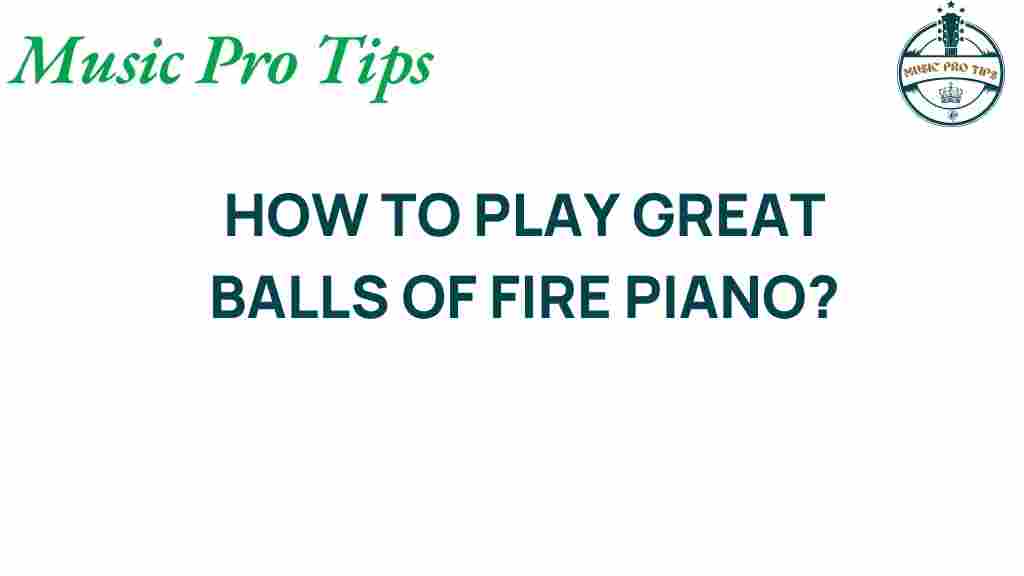Mastering the Art of Great Balls of Fire
When it comes to classic rock and roll, few songs ignite the spirit quite like Great Balls of Fire by Jerry Lee Lewis. This iconic track not only defines an era but also presents an exhilarating challenge for pianists looking to enhance their skills. In this comprehensive piano tutorial, we’ll explore essential music techniques, performance tips, and the unique musical style that makes this song a staple in the repertoire of aspiring and seasoned pianists alike. Whether you’re a beginner or an experienced player, mastering Great Balls of Fire will elevate your piano playing to new heights.
Understanding the Musical Style
Great Balls of Fire was released in 1957 and quickly became a hallmark of Jerry Lee Lewis’s dynamic performance style. The song is characterized by its energetic tempo, distinctive rhythm, and playful lyrics. Here are some key elements to consider when diving into this classic:
- Upbeat Tempo: The song is played at a brisk pace, typically around 140 BPM (beats per minute).
- Rhythmic Patterns: The left hand often plays a boogie-woogie pattern, while the right hand delivers the catchy melody.
- Syncopation: The song features syncopated rhythms that create a lively and engaging sound.
Essential Piano Chords for Great Balls of Fire
Before diving into the song, it’s crucial to familiarize yourself with the piano chords used in Great Balls of Fire. The primary chords are:
- C Major: C – E – G
- F Major: F – A – C
- G Major: G – B – D
These chords form the foundation of the song and will be used throughout your performance. You can find more detailed chord charts online at this resource.
Step-by-Step Piano Tutorial
Now that you have a grasp of the musical style and chords, let’s break down the song into manageable sections for our piano tutorial.
1. Intro
The intro is crucial for setting the energetic tone of the piece. Start with a C major chord and add some rhythmic flair:
- Play the C major chord in the left hand, emphasizing the bass note.
- In the right hand, play the melody using a series of staccato notes for a lively feel.
2. Verse
The verse follows a simple chord progression:
- Start with C major, move to F major, and then to G major.
- Incorporate a boogie-woogie style in your left hand while playing the melody in your right hand.
Practice this section slowly, focusing on your timing and rhythm. Once you’re comfortable, gradually increase your speed.
3. Chorus
The chorus is where you can really let loose. Repeat the catchy melody while driving the rhythm home:
- Use the same chords (C, F, G) but play them with more energy.
- Experiment with octave jumps in your right hand to add excitement.
Performance Tips
As you practice Great Balls of Fire, keep these performance tips in mind:
- Stay Loose: Keep your hands relaxed to allow for fluid motion across the keys.
- Emphasize Dynamics: Play around with the volume, emphasizing certain notes to create a more dynamic performance.
- Engage with the Audience: If performing live, connect with your audience through eye contact and energy.
Troubleshooting Common Challenges
As with any challenging piece, you may face hurdles while learning Great Balls of Fire. Here are some common issues and how to overcome them:
- Timing Issues: Use a metronome to practice keeping a steady tempo.
- Hand Coordination: Isolate the left and right hand parts, practicing them separately before combining them.
- Memory Retention: Break the song into smaller sections and practice each until memorized.
Enhancing Your Musical Techniques
To truly master the song, consider exploring additional music techniques:
- Improvisation: Once you’re comfortable with the basic structure, try adding your flair through improvisation.
- Articulation: Focus on how you attack each note; staccato and legato techniques can greatly enhance your performance.
- Expression: Pay attention to the emotional delivery; let the energy of the song shine through your playing.
Resources for Further Learning
To dive deeper into mastering Great Balls of Fire, consider exploring additional resources:
- Online piano courses that specialize in rock and roll styles.
- Sheet music available at your local music store or online retailers.
- YouTube tutorials that offer visual guidance on playing techniques.
Conclusion
Mastering Great Balls of Fire on the piano is not just about playing the right notes; it’s about capturing the spirit of rock and roll. With practice, attention to detail, and a willingness to express yourself musically, you’ll find joy in performing this classic song. Remember to embrace your unique style as you make it your own. Happy playing!
This article is in the category Theory and created by MusicProTips Team
